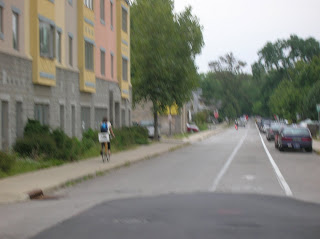







 Some additional reads:
Some additional reads:


 You, who feel so inclined, I think you are just big jerks. I don't think I need to spell out why this is dangerous and selfish.
You, who feel so inclined, I think you are just big jerks. I don't think I need to spell out why this is dangerous and selfish.

 Not even trees in the middle of the sidewalk can stop these intrepid bikateers!
Not even trees in the middle of the sidewalk can stop these intrepid bikateers! bike lane, schmike lane.
bike lane, schmike lane.
ScienceDaily (Sep. 7, 2008) — It seems paradoxical but the more people ride bicycles on our city streets, the less likely they are to be injured in traffic accidents.
International research reveals that as cycling participation increases, a cyclist is far less likely to collide with a motor vehicle or suffer injury and death - and what's true for cyclists is true for pedestrians. And it's not simply because there are fewer cars on the roads, but because motorists seem to change their behaviour and drive more safely when they see more cyclists and pedestrians around.
Studies in many countries have shown consistently that the number of motorists colliding with walkers or cyclists doesn't increase equally with the number of people walking or bicycling. For example, a community that doubles its cycling numbers can expect a one-third drop in the per-cyclist frequency of a crash with a motor vehicle.
"It's a virtuous cycle," says Dr Julie Hatfield, an injury expert from UNSW who address a cycling safety seminar in Sydney, Australia, on September 5. "The likelihood that an individual cyclist will be struck by a motorist falls with increasing rate of bicycling in a community. And the safer cycling is perceived to be, the more people are prepared to cycle."
Experts say the effect is independent of improvements in cycling-friendly laws such as lower speed limits and better infrastructure, such as bike paths. Research has revealed the safety-in-numbers impact for cyclists in Australia, Denmark, the Netherlands, 14 European countries and 68 Californian cities.
"It's a positive effect but some people are surprised that injury rates don't go up at the same rate of increases in cycling," says Sydney University's Dr Chris Rissel, co-author of a 2008 research report on cycling.
"It appears that motorists adjust their behaviour in the presence of increasing numbers of people bicycling because they expect or experience more people cycling. Also, rising cycling rates mean motorists are more likely to be cyclists, and therefore be more conscious of, and sympathetic towards, cyclists."
Safety concerns are among the most significant barriers preventing Australians from cycling, including among those who cycle regularly, according to the report, titled Cycling: Getting Australia Moving. Despite this, over 1.68 million adults cycled in 2006, an increase of almost 250,000 since 2001. During this period, Australian capital cities experienced an average 22 percent increase in bicycle journeys to work. The city of Melbourne led with a 42 percent increase, while the city of Sydney lagged the field with a nine percent increase. 2006 figures reveal that 12,132 Sydneysiders cycle to work.
Dr Rissel says transport authorities should highlight the fun, convenience and health and environmental benefits of cycling, rather than what he views as an undue emphasis on danger and safety messages, which can deter cyclists: "We should create a cycling friendly environment and accentuate cycling's positives rather than stress negatives with 'safety campaigns' that focus on cyclists without addressing drivers and road conditions. Reminding people of injury rates and risks, to wear helmets and reflective visible clothes has the unintended effect of reinforcing fears of cycling which discourages people from cycling."
 Waiting patiently for owners at brunch.
Waiting patiently for owners at brunch. Brightening up an otherwise dull-looking house.
Brightening up an otherwise dull-looking house.
 (click on the photo to see full-size)
(click on the photo to see full-size)
 A vintage style in an overly mountain-bikey town.
A vintage style in an overly mountain-bikey town.

 And my own trusty steed.
And my own trusty steed.
 Riding is fun for the ladies throughout the generations. Here is a young girl and her father riding by.
Riding is fun for the ladies throughout the generations. Here is a young girl and her father riding by. An older woman heading to the farmer's market.
An older woman heading to the farmer's market. Cruising down Kirkwood.
Cruising down Kirkwood. Heading home in the evening on her old trusty ten-speed (or so).
Heading home in the evening on her old trusty ten-speed (or so).

 On my commute to town.
On my commute to town.  Category 1: typical cyclist in Bloomington: Helmet, backpack, and mountain bike.
Category 1: typical cyclist in Bloomington: Helmet, backpack, and mountain bike.  A second category of cyclists in Bloomington: bike of choice--ten speed, no helmet.
A second category of cyclists in Bloomington: bike of choice--ten speed, no helmet. Another example of the milk crate/kid cargo system.
Another example of the milk crate/kid cargo system. 